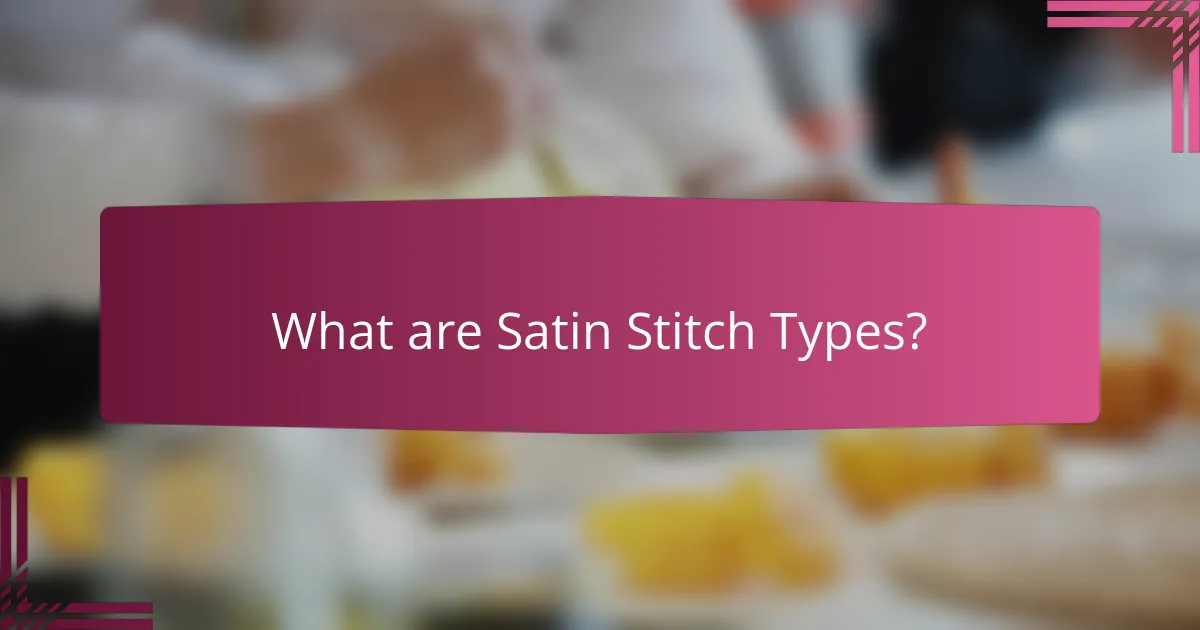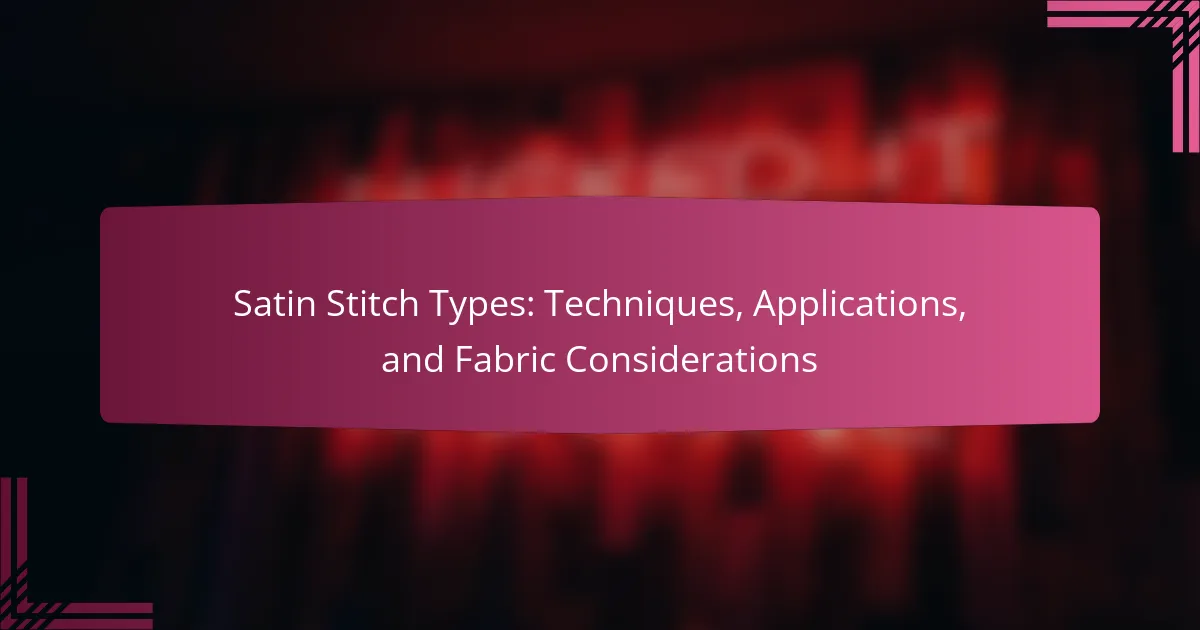
What are Satin Stitch Types?
Satin stitch types are specific embroidery techniques that create a smooth, lustrous finish. They are characterized by closely spaced parallel stitches. Common types include the standard satin stitch, which uses a simple back-and-forth motion. Another type is the split satin stitch, which divides the stitch for added texture. The double satin stitch involves layering stitches for more depth. Variations also exist for different fabric types, such as lightweight or heavy fabrics. These techniques are widely used in decorative embroidery and appliqué work. Each type serves unique aesthetic and functional purposes in textile design.
How do different Satin Stitch Types vary?
Different satin stitch types vary primarily in their width, density, and application technique. The width can range from narrow to wide, affecting the overall look of the stitch. Density refers to how closely packed the stitches are, influencing texture and coverage. Application techniques include variations like traditional satin stitch, which is smooth and even, and split satin stitch, which creates a textured effect. Each type serves different purposes, such as decorative embellishments or functional stitching. The choice of satin stitch type can also depend on the fabric used, as some stitches work better on certain materials. For instance, lightweight fabrics may require narrower, less dense stitches to avoid puckering.
What are the key characteristics of each Satin Stitch Type?
There are several key characteristics of each Satin Stitch type. The standard satin stitch features a smooth, shiny finish and is commonly used for outlining shapes. The narrow satin stitch is thinner, allowing for more intricate designs with a delicate appearance. The wide satin stitch provides a bold look, ideal for filling larger areas. The angled satin stitch offers a unique texture by creating diagonal lines, enhancing visual interest. The split satin stitch combines traditional satin elements with open spaces, adding depth to designs. Each type is suitable for different applications, depending on the desired aesthetic and fabric type. These characteristics help in selecting the appropriate satin stitch for specific embroidery projects.
How does the stitch length influence the appearance of Satin Stitches?
Stitch length significantly influences the appearance of Satin Stitches. Shorter stitch lengths create a denser and more polished finish. This results in a smooth surface, enhancing the satin effect. Conversely, longer stitch lengths may lead to a looser appearance. A looser stitch can diminish the sheen and overall quality of the satin finish. Additionally, varying stitch lengths can affect the fabric’s drape and texture. For example, on lightweight fabrics, shorter stitches maintain integrity, while longer stitches may cause puckering. Overall, the choice of stitch length is crucial for achieving the desired visual effect in Satin Stitches.
What techniques are used in creating Satin Stitches?
Satin stitches are created using specific embroidery techniques. The primary technique involves using a sewing machine or hand embroidery to form closely spaced parallel stitches. This method creates a smooth, shiny surface characteristic of satin stitches.
For machine embroidery, the zigzag stitch is commonly used. The width and length of the stitch can be adjusted to achieve the desired effect. In hand embroidery, the technique requires careful placement of stitches to ensure a dense and even finish.
Additionally, using a stabilizer can help maintain the shape of the fabric during stitching. This prevents puckering and ensures a clean, professional look. The choice of thread also plays a crucial role in achieving the satin finish. High-sheen threads are preferred for their reflective quality.
These techniques collectively contribute to the effective creation of satin stitches, enhancing both the aesthetic and functional aspects of the embroidery.
How do you achieve a smooth finish with Satin Stitches?
To achieve a smooth finish with satin stitches, ensure the fabric is taut and properly stabilized. Use a high-quality embroidery thread that has a smooth texture. Select the appropriate needle size for the thread to avoid puckering. Maintain consistent stitch length for uniformity. Use a slow and steady sewing speed to prevent thread breakage. Adjust the tension settings on the machine to suit the thread and fabric type. These practices contribute to a clean and polished appearance in satin stitching.
What tools are essential for executing Satin Stitch techniques?
Essential tools for executing Satin Stitch techniques include an embroidery machine, stabilizer, and appropriate thread. An embroidery machine allows for precise stitching and control. Stabilizer supports the fabric during stitching, preventing distortion. High-quality thread ensures smooth and consistent stitches. Scissors for trimming threads and a hoop for holding fabric in place are also necessary. These tools collectively facilitate successful Satin Stitch execution.
What applications are best suited for Satin Stitches?
Satin stitches are best suited for applications requiring a smooth, shiny finish. Common uses include decorative embroidery on garments, such as logos and monograms. They are also ideal for embellishing home textiles like cushions and table runners. Satin stitches work well on fabrics with a smooth surface, such as satin and silk. The technique is effective for creating detailed designs with a high thread count. Additionally, satin stitches are often used in quilting for decorative borders. Their versatility extends to crafting and DIY projects, enhancing visual appeal.
In what types of projects are Satin Stitches most commonly used?
Satin stitches are most commonly used in embroidery projects. They create smooth, glossy finishes on fabric. These stitches are ideal for outlining designs and filling in shapes. They are frequently used in decorative items like quilts and garments. Satin stitches enhance logos and monograms on apparel. They are also popular in home decor projects, such as cushions and wall hangings. Their versatility allows for use in both hand and machine embroidery. The smooth texture of satin stitches adds a professional touch to various textiles.
How do Satin Stitches enhance the aesthetic of fabric items?
Satin stitches enhance the aesthetic of fabric items by creating a smooth, glossy finish. This stitch technique adds depth and dimension to designs. The raised texture of satin stitches catches light beautifully, contributing to visual appeal. Satin stitches can be used to outline shapes or fill in areas, offering versatility in design. This technique is particularly effective in embroidery, where intricate patterns are desired. The luxurious appearance of satin stitches elevates the overall quality of fabric items. They are commonly used in fashion, home décor, and textile art. Their ability to create a polished look makes them popular among designers and crafters.
What fabric considerations are important for Satin Stitches?
Satin stitches require specific fabric considerations for optimal results. The fabric should have a smooth surface to allow the stitches to glide easily. Additionally, a tightly woven fabric prevents fraying and maintains stitch integrity. Fabrics like silk, satin, and polyester are ideal due to their sheen and structure. It is also important to choose a fabric weight that supports the density of the satin stitch. Heavier fabrics may distort the stitch, while lighter fabrics may not hold the stitch well. Proper stabilizers should be used to support the fabric during stitching. These considerations ensure clean, consistent satin stitches.
What types of fabric work best with Satin Stitches?
Satin stitches work best on smooth, tightly woven fabrics. Ideal options include cotton, silk, and polyester. These fabrics allow for clean, defined stitches. They also prevent fraying and maintain stitch integrity. Fabrics with a slight sheen enhance the appearance of satin stitches. Additionally, lightweight fabrics are easier to manipulate during stitching. Heavy fabrics may cause difficulty in achieving precise satin stitches. Ultimately, the right fabric choice enhances the overall quality of the embroidery.
How do fabric weight and texture affect Satin Stitch application?
Fabric weight and texture significantly influence Satin Stitch application. Heavier fabrics provide stability, allowing for smoother stitching. They reduce the risk of puckering and distortion during the embroidery process. Conversely, lighter fabrics may require additional stabilizers to prevent shifting. Textured fabrics can complicate the stitch formation, leading to uneven results. A smooth surface enhances the stitch’s appearance and accuracy. For optimal results, matching the fabric’s weight and texture with the appropriate Satin Stitch technique is essential.
How can you troubleshoot common issues with Satin Stitches?
To troubleshoot common issues with satin stitches, first examine the thread tension. Improper tension can lead to puckering or loose stitches. Adjust the tension settings on your sewing machine accordingly. Next, check the needle type and size. A ballpoint needle is often recommended for satin stitches on knits. Ensure the fabric is suitable; slippery materials may require stabilizers to prevent shifting. If stitches are skipping, inspect the needle for damage and replace it if necessary. Lastly, test stitch length; a shorter length often yields better results for satin stitches.
What are the most frequent problems encountered with Satin Stitches?
Frequent problems encountered with satin stitches include puckering, thread breakage, and uneven stitching. Puckering occurs when fabric tension is inconsistent. This often results in a distorted appearance. Thread breakage can happen due to improper needle size or tension settings. Uneven stitching may arise from incorrect stitch length or fabric type. These issues can lead to a less polished final product. Proper technique and equipment adjustments can mitigate these problems. Regular maintenance of sewing machines also helps maintain stitch quality.
What tips can help improve the quality of Satin Stitches?
Use a stabilizer to support the fabric during stitching. This prevents puckering and helps maintain stitch integrity. Select the right needle type for your fabric; a sharp needle works best for smooth fabrics. Ensure your thread is of high quality, as inferior thread can lead to fraying and breakage. Adjust the tension settings on your sewing machine to achieve even stitches. Practice consistent speed while sewing to maintain uniformity in stitch appearance. Keep the fabric taut but not stretched to avoid distortion. Regularly clean your machine to prevent lint buildup, which can affect stitching quality.
Satin stitch types are specialized embroidery techniques that produce a smooth, lustrous finish through closely spaced parallel stitches. This article covers various satin stitch types, including standard, split, and double satin stitches, along with their key characteristics, applications, and the influence of fabric considerations on their execution. It discusses essential tools and techniques for creating satin stitches, troubleshooting common issues, and tips for improving stitch quality. By understanding these elements, readers can effectively utilize satin stitches in their embroidery projects for enhanced aesthetic appeal.
